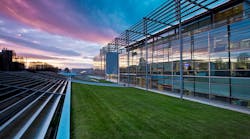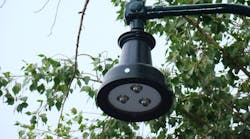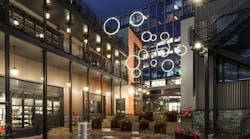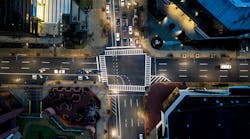A lifetime service award was presented to Garry Bradford, a Canadian who was with Stresscrete/King Luminaire (now providing LED options) before he retired. Before the actual presentations were underway, attendees were welcomed by Benjamin Franklin who while 'kiting' through his address and 'keying' in on conference topics, exclaimed, “As you know, I am an Illuminating Engineer.”
DOE SSL Program Manager, Jim Brodrick, covering ‘Why Are We Here’ and presenting the savings potential of street lighting conversion to SSL, gave the opening address.
Brodrick reminded everyone that not all LEDs are created equal. Brodrick also discussed DOE resources, reminding everyone about the upcoming webcast regarding ENERGY STAR for Outdoor Area Lighting on October 8th and the new Municipal Street Lighting Consortium, of which there was a high level of interest expressed from the audience. Brodrick also released the new DOE street lighting video. Brodrick will be back on Wednesday to discuss ARRA 'stimulus' funding and the array of SSL street lighting projects underway. Rumour has it that the DOE may have Compiled the data that may allow everyone to look up current and potential projects and we will learn more about this and the 'Energy Efficiency and Conservation Block Grant' program on Wednesday. Because of 'Buy America' stimulus funding some Canadian Manufacturers have been refused into the process.
Back to the podium on Monday was Cree's Mark McClear who gave an abridged version of his day-long LED training workshop on Sunday. McClear also presented in 2008 and displayed his 2008 SALC 27th year 'Roadmap' slide and the progress since then, highlighting the advancements in 2009 alone. In looking forward, McClear quoted his CTO with respect to the general question as to 'when will we see ...' by saying 'You can't put an egg timer on innovation or invention.' He covered standards implementation. He displayed his 'LEDs in the Wild West' binning slide, covering the 'lighting quality' aspect and results due to binning throughout the industry.
McClear went on to expand his retraction on the matter the LED outdoor cobra-head retrofit lamps, taking back and apologizing for previous comments. Not only would McClear feel safe to eat an LED, he had to eat his words as he has seen the results of effective thermal management in this design, where three manufacturers observed may have solved the thermal issues. McClear, while in past has referred to these lamps as a 'heat source in s thermos' is now seeing admirable performance from some tested products.
Ron Gibbons of the Virginia Tech Transportation Institute (VTTI) discussed the physiology of the eye and the reception of light in vision. Ron is known for the development of the Roadway Lighting Mobile Measurement System (RLMMS), a mobile measurement system that can take readings 'on the fly' without closing the street or bridge in the case of the St. Anthony's Bridge GATEWAY demonstration project. Ron also presented a video, which demonstrated the eye tracking target detection system. A feature regarding VTTI, their 'Smart Road' and the RLMMS and eye tracking systems is planned. Ron concluded that there is definitely credence and efficacy in broad-spectrum light sources for lower illumination levels.
Joe Howley from GE gave a lighting legilsaltion update, highlighting that mercury vapour is coming to the real end of life of the technology and that municipalities best plan for future replacement as MV ballasts are already outlawed. Municipalities with this type of lighting stock should be on the radar of SSL outdoor manufacturers.
Once again, David Keith gave an outstanding and passionate dissertation on the non-economic issues in outdoor lighting in his presentation entitled 'What We Do Know Can Hurt Us'. Keith detailed the 'unanticipated (and probably unintended) consequences' such as light pollution and sky glow and the possible health effects through circadian rhythm disruption. Dr. Brainard will go into further detail with more in depth research results regarding this matter on Wednesday. Keith provided attendees with his insight into 'stimulus' but unfortunately not of the funding type. Light Pollution and Light and Health discussion and issues are becoming a far more widespread concern and affecting lighting decisions more and more ever day.
In the afternoon breakout networking sessions, some great dialogue was observed. Plasma light sources and legislation played heavy in the discussion in the Emerging Technologies forum with resounding question to Mark McClear as to how this will effect LED, especially how LED will respond to plasma. Mark responded that all energy efficient technology must be considered. McClear as well as Brodrick were asked about the 4-foot linear LED tube replacement. Brodrick responded from the DOE CALiPER perspective and McClear simply said that it wasn't a good application for LED.
Ed Smalley from Seattle City Light asked the attendees about demographics, resulting in a large showing of manufacturers present, a good representation of consultants and specifiers, as well as municipalities and utilities, with quite few contemplating or preparing for lighting changes or projects in the next 6 to 12 months. The white light forum continued the discussion on visual perception benefits, mesopic light measurement values and the light and health issues surrounding daylight emulating white light. The Municipal forum discussion surrounded the procurement process and 'how to buy' or whether to use a consultant and how to decide and pick the appropriate firm or person, as well as environmental impact considerations and of course, capital costs.
The day also included an informative discussion with Clinton Climate Initiative personnel regarding the new direction being taken on assessing municipal opportunities and demand for SSL technology and the financing modeling resource that can assist municipalities in the acquisition of SSL outdoor lighting. I was also able to take Vincent Finn, Canada's Trade Commissioner at the Philadelphia Canadian Consulate on an exhibit floor tour to meet the 6 Canadian manufacturers exhibiting at the conference, representing 15% of the companies with SSL outdoor lighting product offerings.
Tuesday's program will highlight the GATEWAY SSL demonstration project on the St. Anthony's Bridge and the much anticipated SSL municipal projects presentation from Nancy Clanton, as well as presentations regarding municipal and utility funding for emerging technologies AKA SSL and utility management of lighting. Peter Hochstein, President of SSL outdoor luminaire manufacturer Relume will present on the topic of lighting control and monitoring.
Keep looking into the light from LEDs Magazine for the next instalment from the IES SALC conference.




